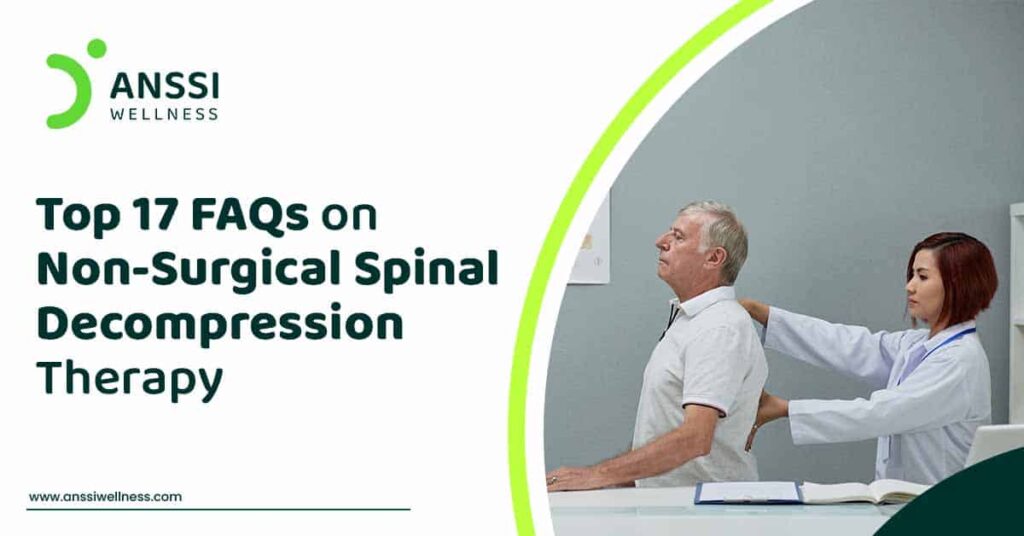If you are experiencing chronic back, shoulder, or neck pain, non-surgical spinal decompression treatment could be the right effective option. Is this the first time you have heard about non-surgical spinal decompression treatment? If so, you might have many questions about this unique treatment that can help in pain relief and mobility improvement.
In this article, our team at ANSSI Wellness answers several commonly asked questions regarding non-surgical spinal decompression treatment. So, let us discuss what makes this particular treatment option a safe and effective way to pain relief.
What is Non-Surgical Spinal Decompression Treatment?
You experience musculoskeletal pain that usually originates from the intervertebral discs, muscles, or compressed nerves due to the build-up of pressure in these areas. Doctors use non-surgical decompression treatment to stretch the spinal column naturally to get rid of that pressure off your spine.
Many who haven’t found any relief from physiotherapy, medications, massage therapy, or steroids, opt to try non-surgical spinal decompression treatment even when they are recommended to undergo surgery. At times, surgery fails to resolve pain and mobility issues.
How Does Non-Surgical Spinal Decompression Work?
The patient is first made to lie down on a segmented table supported by a computerised mechanism. As a next step, each segment moves in a targeted way to slowly and gently stretch the spinal column. You may even experience a cracking or popping sound as the pressure gets removed.
Is Spinal Decompression Treatment Painful?
Spinal stretching might sound scary. However, this treatment does not cause any pain as it’s a natural, gentle, and effective mode of pain relief.
Which Conditions Does the Spinal Decompression Treatment Treat?
Non-surgical spinal decompression treatment can treat several conditions connected to intervertebral discs such as:
- Shoulder pain
- Back pain
- Neck pain
- Leg pain
- Pinched nerves
- Tingling and numbness in upper and lower extremities
- Muscle tension
- Sciatica
- Facet syndrome
- Bulging or herniated disc
- Degenerative disc disease
- Spinal stenosis
Does Spinal Decompression Treatment Offer Lasting Results?
Addressing the cause of symptoms is the only effective way to achieve lasting results. This is where spinal decompression treatment helps. However, it’s not administered as a standalone treatment. Instead, this treatment is often added to a comprehensive treatment plan to achieve optimal results.
By stretching the spinal column, there will be a proper flow of nutrients and blood to the discs and soft tissues, which in turn improves healing. Furthermore, the possibility of recurring pain is reduced.
How Effective is Non-Surgical Spinal Decompression Treatment?
The effectiveness of non-surgical spinal decompression treatment depends on the condition, duration of the treatment, and compliance with the post-care regimen.
Am I The Right Candidate to Undergo Non-Surgical Spinal Decompression Treatment?
To know if you’re the right candidate for this treatment, contact ANSSI Wellness. Our doctors will examine your condition and confirm if this treatment works for you.
Are There Any Side Effects?
No. As this treatment is non-surgical and drug-free, there is no risk of infection and you do not experience any side effects.
Why Have I Not Heard of This Treatment Before?
Spinal decompression treatment is quite common in the US and UK, although it’s new in India. The treatment is being introduced in India at several locations, with the help of necessary equipment and expertise.
Can I Drive Home After Treatment?
Yes. Patients can drive home after undergoing the spinal decompression treatment.
Is There Any Research Evidence to Support the Effect of Spinal Decompression Therapy?
Yes. Studies have reported that spinal decompression works for chronic back pain and neck pain that may require surgical intervention. By strictly following the sessions and recommendations, this treatment can keep you pain-free [1, 2].
What Can I Expect?
After a session of non-surgical spinal decompression, you might feel as if you’ve had a workout, as your spine remains stretched for some time. You can go back to your routine life after undergoing spinal decompression. However, it’s better to avoid twisting or heavy lifting that could put extra pressure on your spine.
How Many Sessions Should You Undergo?
Depending on the severity of the condition, you will have to undergo 20-30 sessions over a period of 3-6 weeks. The spinal decompression treatment is initially conducted on a daily basis with each session lasting for 20-30 minutes each. Most people will start feeling relief within 7-12 sessions on average. It’s too rare to find a patient’s condition getting worse.
Is Spinal Decompression Treatment a One-Stop Solution to Your Pain?
Non-surgical spinal decompression treatment is recommended to treat the root cause of pain and not just mask the symptoms temporarily. Unless you re-damage your spine or skip post-treatment care, you do not have to undergo this treatment again. However, the protocol varies for every patient.
Who is Ineligible to Undergo Spinal Decompression Treatment?
The following conditions or criteria may disqualify a patient from receiving spinal decompression treatment:
- Patients above 70 years
- Osteoporosis
- Pregnancy
- Severe obesity
- Surgery involving placement of rods or screws in the spine
- Prior lumbar fusion within the last six months
- Grade 3 and 4 spondylolisthesis
- Lumbar spine fracture
- Disc space infections
- Aortic aneurysm
- Abdominal cancer
- Pelvic cancer
- Metastatic cancer
So, make sure to consult the spinal decompression specialist to find out if you are the right candidate for this treatment.
Can Non-Surgical Spinal Decompression Be Successful Where Prior Surgery Has Failed?
Non-surgical spinal decompression can often be successful in providing relief for patients who continue to experience pain even after undergoing surgery. However, a personalised assessment is required to ensure the treatment’s safety and effectiveness. A person who has undergone spinal fusion or had multiple surgeries before may not be eligible for spinal decompression.
Does Spinal Decompression Work Even if Traction, Physical Therapy, and Chiropractic Fail?
Yes. The reason is traction, physical therapy, and chiropractic practices reduce the pressure within the spinal discs to as low as 40 mm Hg. However, spinal decompression reduces pressure up to -110 mm Hg3. An experienced specialist with a high-quality spinal decompression table can ensure the best outcomes.
About ANSSI:
ANSSI Wellness focuses on improving the quality of life for patients suffering from spinal issues, aiming to provide relief where other conventional treatments have failed. Through advanced non-surgical spinal decompression treatment, ANSSI is committed to helping patients avoid surgery and recover in a safe, effective, and compassionate environment.
Yes, in many cases, the bulging disc symptoms go away after a period of time.
MRI is the best diagnostic test to detect herniated and bulging discs.
Massage can provide short-term relief from chronic back pain caused by a bulging disc.



